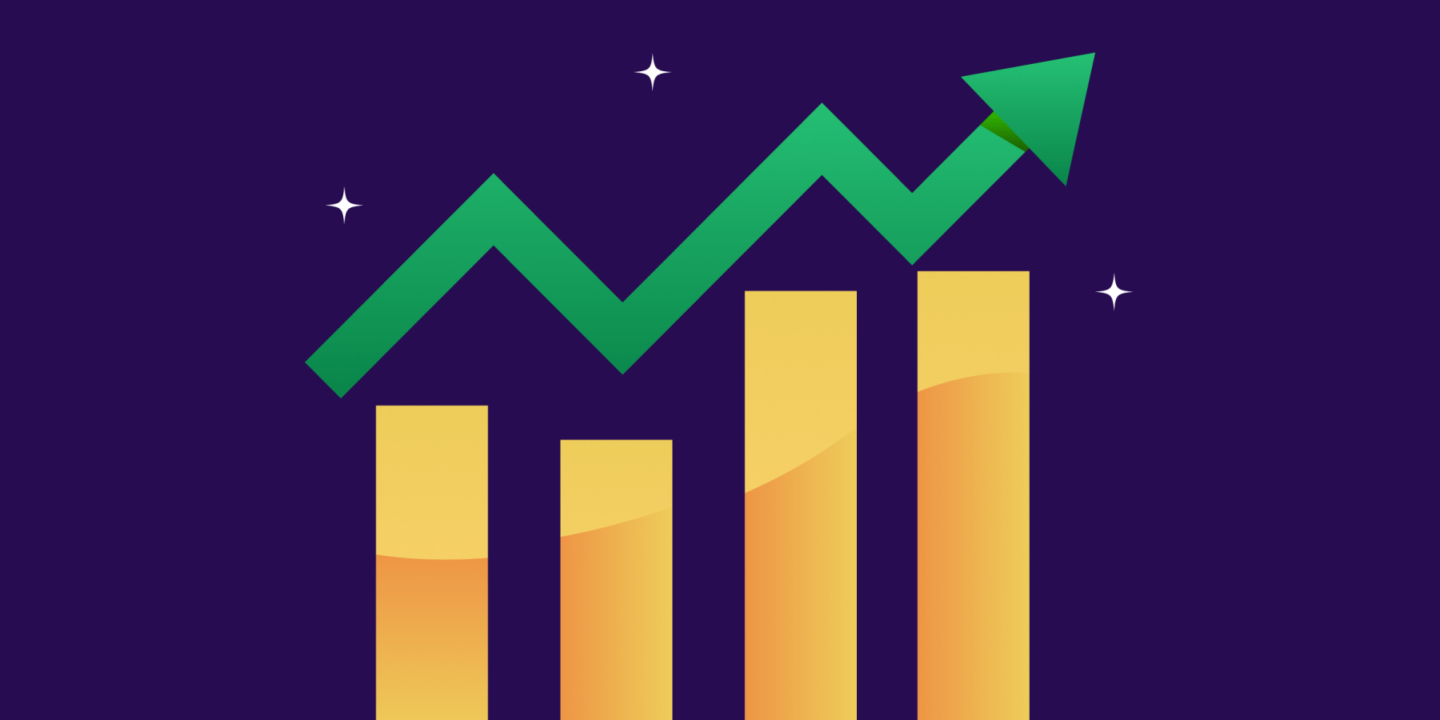
When will Shiba Inu, the infamous meme coin, hit $1? Currently trading for $0.0000129, if it ever touches $1, I would instantly make 100000x on my investment. Imagine purchasing $10 worth of crypto and converting it into generational wealth. Are you buying this? Did you get into crypto with a similar promise? If yes, this article is tailor-made for you. Today, we are going to talk about something called market cap in cryptocurrency.
Oh, the previous example? Well, if Shiba Inu ever hits $1, it would become 5x greater than the world’s GDP. Let that sink in for a moment. Moving on. A lot of us are sold these dreams of riches through a similar story. But the ones who truly understand market cap are barely caught. So why not hop on to the enlightened bandwagon? Read on!
What Is Market Cap in Cryptocurrency?
Market cap is the total value of a cryptocurrency. It is derived by multiplying the current price of the cryptocurrency with the total coins in circulation. For example, at the time of writing this, Bitcoin is trading at $21,077, and 19.1 million of them have been mined so far. Multiplying these two figures, we reach a market cap of $403B. In the past, Bitcoin’s market cap has also reached $1T.
Since the price and number of tokens in circulation constantly change, so is the market cap. Similarly, Ethereum is trading at $1668 as of September 6th, with a total circulation of 122 million. Can you guess the market cap of Ethereum?
Based on the market cap, cryptocurrencies can be divided into three categories. If you are an avid stock market investor, this should not be new for you. Let us explore.
Large-cap cryptocurrencies
Cryptocurrencies with a market cap greater than $10B are generally considered large-cap cryptocurrencies. Large-cap cryptos are often less risky (within the crypto ecosystem) and tend to have established themselves over time. If you take cues from the stock market, large-cap companies are often considered a conservative investment. This is because the market cap reflects a company’s size or total value. The larger market cap would mean a big and hence stable and safer bet.
Applying the basic principles of risk to reward, these cryptos are considered to have lesser growth potential as they have already grown significantly already. Examples of large-cap cryptos would be BTC, ETH, BNB, etc.
Mid-cap cryptocurrencies
Mid-cap cryptocurrencies range between $1B and $10B. They often possess a higher risk as compared to large-cap cryptos. With that being said, quite often, these cryptocurrencies have greater growth potential. Some examples of mid-cap cryptocurrencies are MATIC, UNI, AVAX, etc.
Small-cap cryptocurrencies
As you might have guessed, these cryptocurrencies generally have a market cap below $1B. They are highly volatile and risky and can go to zero within minutes. One needs to exercise extreme caution backed up by thorough research before investing in these cryptos. Some examples of these cryptos are MKR, ZCash, Helium, etc.
How to Calculate Market Cap of Crypto?
The formula for calculating the market cap of any crypto remains the same. All you need to know is the circulating supply and the current price. Simply multiply these two, and you will arrive at the market cap.
Let us take a simple example. Any stablecoin like USDT or USDC would always mimic the price of a dollar. So, the market cap would always be equal to:
Total coins in circulation X $1 = Market Cap of Stablecoin
With that logic, USDT stands at $62B and USDC at $54B
In another example, Coingecko calculates the market cap of the entire industry. This is done by adding the market cap of individual 12,000+ tokens. As a result, the crypto industry’s market cap stands at $1.06T as of 6th September.
How to Calculate the Price of a Cryptocurrency?
Now that you have understood how to derive market cap, let us put it to greater use by deriving prices. Needless to say that the price formula becomes:
Price of Cryptocurrency: Total Market Cap/Total number of tokens in circulation.
That wasn’t fun? Let us try to predict the price of Bitcoin using this technique.
The market cap of gold stands at about $8T. Our beloved Bitcoin is considered digital gold. So if Bitcoin ever hits a market cap of $8T, can you guess its price?
The total number of Bitcoins to exist ever are 21 million. Simply divide the market cap (8 trillion) by the total supply (21 million). This yields a figure of ~$400K.
So if Bitcoin ever matches the market cap of gold, it would be a jump of 20x from its current price. You can compare cryptocurrencies with other assets using a similar model. For example, it would be interesting to compare the market cap of Ethereum with the market cap of oil because it is termed digital oil by many.
Why Is Market Cap Important in Crypto?
Market cap is an extremely important indicator of cryptocurrency’s popularity in the long term. How? Let us try to figure that out.
1. Comparison with peers
Polygon and Loopring are two different layer 2 scaling solutions. Simply put, these two different coins belong to two different networks responsible for helping Ethereum in speed and throughput. Polygon (MATIC) is currently priced at $0.8, and Loopring (LRC) is priced at $0.3.
Is this information enough to assume that Polygon is bigger than Loopring? Absolutely not. If you compare the market cap of both these cryptocurrencies, you will see that they are roughly $5-6 billion. This means that given the token supply and current price, they are very comparable to each other rather than exhibiting a stark difference.
You can deploy the same methodology to compare different peers within the crypto market to understand the size of a project.
2. Comparison with other industries
In the Bitcoin vs Gold example above, we tried to compare two completely different asset classes to establish a correlation.
A similar analogy can be used to understand the size of Bitcoin. A lot of skeptics think that Bitcoin is a passing fad and it might die soon. However, the current market cap of Bitcoin is more than that of Meta (Erstwhile Facebook). It is extremely hard to ignore something of that size and quantum.
3. Comparing performance
One can also use the market cap to find out if the crypto is underperforming or not. For example, say there are two mainstream blockchains like Ethereum and Solana. If the market cap of Ethereum is 50 times Solana, but the revenue is almost similar, it is safe to assume that Ethereum is underperforming and price correction is on the charts.
In a similar fashion, you could find out some cryptos that are undervalued and could go on a rally in the near term.
What Does Crypto Market Cap Mean for Investors?
Before reviewing the implications of the crypto market cap for investors, let us look into what it means for the stock market.
From the stock market perspective, understanding the market cap helps investors to know how much a particular company is worth. It allows them to categorize the company as small-cap, mid-cap, or large-cap. Large-cap companies are typically less risky (compared to mid-cap and small-cap) as these are well-established and stable companies. Based on this information, people can make investment decisions.
If we look into the crypto market, we can draw similarities with the stock market. Like stocks, the crypto market cap denotes the size of the crypto project and the risk associated with it. It helps the investors to pick the project based on their risk profile. For example, risk-averse investors generally stick to large-cap projects like Bitcoin or Ethereum. Whereas risky investors explore mid or small-cap projects with the expectation of significant returns.
Important Factors Besides Crypto Market Capitalization
Relying solely on the market cap for assessing a project is not advisable as various other factors can affect the crypto.
Below are the metrics to look for in a cryptocurrency apart from market cap.
1. Active trading volume
Active trading volume is a critical technical indicator for understanding the cryptocurrency’s true value. Higher the trading volume, the higher the traction for the project among the investors.
2. Volatility
Higher volatility can be favorable for investors expecting higher returns and bad for investors looking for stable returns since it is a double-edged sword.
3. Max supply & circulating supply
Max supply is the maximum amount of cryptos that ever will be available to the users. Whereas circulating supply is the total amount available to users now. For instance, Bitcoin is well known for its max supply of 21 million. As of October’22, more than 19 million BTCs are circulating in the market.
Suppose a coin has a low circulating supply compared to its max supply. In that case, there is a possibility of that crypto suddenly flooding the market with huge volumes of uncirculated supply, thereby crashing the price of the coin.
Conclusion
Market cap is one of the very powerful and simple tools to gauge a cryptocurrency. Appropriate knowledge of the market cap would make sure that you don’t fall for pump-and-dump schemes. And if you are looking for a solution that might help you in this realm by segregating cryptos by a theme, look no further. Head over to Coin Sets to know more.
FAQs
1. What is a good market cap for crypto?
Market cap is the product of total coins in circulation and the price of a cryptocurrency. A good or relatively bigger market cap signifies a bigger and safer project. As a rule of thumb, crypto projects with a market cap greater than $10B are considered good (large-cap cryptos)
2. What is the total crypto market cap?
The total crypto market cap keeps on changing based on the prices of the tokens. Currently, it stands at $1.07 trillion. The total crypto market cap is calculated by adding the market cap of individual 12,000+ tokens.
3. Is a high market cap good?
A high market cap often means a proven business model and relatively stable crypto. However, it also means that the project/crypto/company has already grown over a period of time, and the probability of exponential growth is lesser in the future. However, there is still room for steady growth.
4. How to determine the market cap of crypto?
Market cap is determined by multiplying the price of the crypto with the total coins in circulation for that crypto. Cryptos can be generally categorized into three categories based on the market cap; large-cap, mid-cap, and small-cap. Large-cap cryptos are those with a market cap greater than $10B. Mid-cap cryptos have a market cap between $1B and $10B. And small-cap cryptos are those with under $1B.





